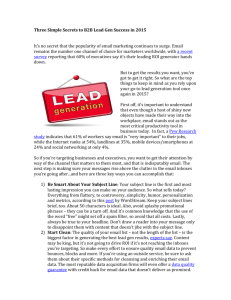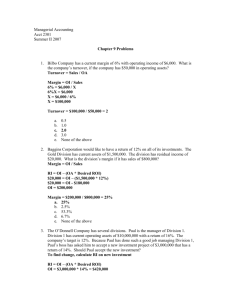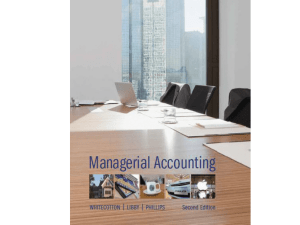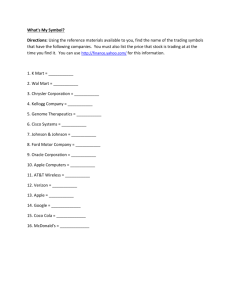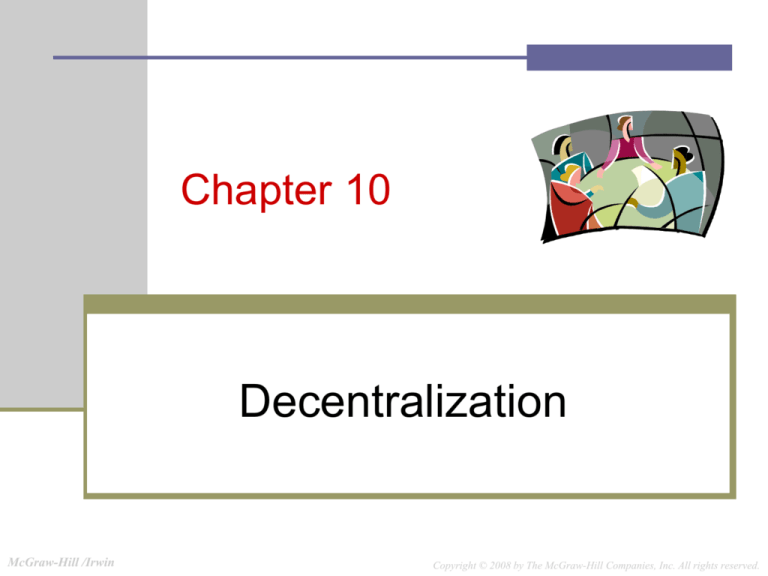
Chapter 10
Decentralization
McGraw-Hill /Irwin
Copyright © 2008 by The McGraw-Hill Companies, Inc. All rights reserved.
10-2
Decentralization in Organizations
Benefits of
Decentralization
Lower-level managers
gain experience in
decision-making.
Lower-level decision
often based on
better information.
Top management
freed to concentrate
on strategy.
Decision-making
authority leads to
job satisfaction.
Lower-level managers
can respond quickly to
customers.
10-3
Decentralization in Organizations
Lower-level managers
may make decisions
without seeing the
“big picture.”
Lower-level manager’s
objectives may not
be those of the
organization.
May be a lack of
coordination among
autonomous
managers.
Disadvantages of
Decentralization
May be difficult to
spread innovative ideas
in the organization.
10-4
Cost, Profit, and Investments Centers
Cost
Center
Profit
Center
Cost, profit,
and investment
centers are all Responsibility
known as
Center
responsibility
centers.
Investment
Center
10-5
Cost, Profit, and Investments Centers
Cost Center
A segment whose
manager has
control over costs,
but not over
revenues
or investment
funds.
10-6
Cost, Profit, and Investments Centers
Profit Center
A segment whose
manager has control
over both costs and
revenues,
but no control over
investment funds.
Revenues:
Sales
Interest
Other
Costs:
Mfg. costs
Commissions
Salaries
Other
10-7
Cost, Profit, and Investments Centers
Investment Center
A segment whose
manager has control
over costs, revenues,
and investments in
operating assets.
Investment center
managers are usually
evaluated using return
on investment (ROI) or
residual income.
Corporate Headquarters
10-8
Responsibility Centers
Investment
Centers
Operations
Vice President
Salty Snacks
Product Manager
Bottling Plant
Manager
Beverages
Product Manager
Warehouse
Manager
Superior Foods Corporation
Corporate Headquarters
President and CEO
Finance
Chief FInancial Officer
Legal
General Counsel
Personnel
Vice President
Confections
Product Manager
Distribution
Manager
Cost
Centers
Superior Foods Corporation provides an example
of the various kinds of responsibility centers that
exist in an organization.
10-9
Responsibility Centers
Superior Foods Corporation
Corporate Headquarters
President and CEO
Operations
Vice President
Salty Snacks
Product Manager
Bottling Plant
Manager
Beverages
Product Manager
Warehouse
Manager
Finance
Chief FInancial Officer
Legal
General Counsel
Personnel
Vice President
Confections
Product Manager
Distribution
Manager
Profit
Centers
Superior Foods Corporation provides an example
of the various kinds of responsibility centers that
exist in an organization.
10-10
Responsibility Centers
Superior Foods Corporation
Corporate Headquarters
President and CEO
Operations
Vice President
Salty Snacks
Product Manager
Bottling Plant
Manager
Beverages
Product Manager
Warehouse
Manager
Finance
Chief FInancial Officer
Legal
General Counsel
Personnel
Vice President
Confections
Product Manager
Distribution
Manager
Cost
Centers
Superior Foods Corporation provides an example
of the various kinds of responsibility centers that
exist in an organization.
10-11
Decentralization and Segment
Reporting
A segment is any
part or activity of an
organization about
which a manager
seeks cost,
revenue, or profit
data. A segment
can be . . .
An Individual
Quick MartStore
A Sales Territory
A Service Center
10-12
Traceable and Common Fixed Costs
In segment reports, traceable
fixed costs should be distinguished
from common fixed costs.
10-13
Identifying Traceable Fixed Costs
Traceable costs arise because of the existence of a
particular segment and would disappear over time if
the segment itself disappeared.
No computer
division means . . .
No computer
division manager.
10-14
Identifying Common Fixed Costs
Common costs arise because of the overall
operation of the company and would not disappear
if any particular segment were eliminated.
No computer
division but . . .
We still have a
company president.
10-15
Learning Objective 1
Compute the return on
investment (ROI) and show how
changes in sales, expenses, and
assets affect an organization’s
ROI.
10-16
Return on Investment (ROI) Formula
Income before interest
and taxes (EBIT)
Net operating income
ROI =
Average operating assets
Cash, accounts receivable, inventory,
plant and equipment, and all other
assets held for operating purposes.
10-17
Net Book Value vs. Gross Cost
Most companies use the net book value of
depreciable assets to calculate average
operating assets. With this approach, ROI
mechanically increases over time as the
accumulated depreciation increases.
Acquisition cost
Less: Accumulated depreciation
Net book value
An alternative to net book value is the gross cost of
the asset, which ignores accumulated depreciation.
10-18
Return on Investment (ROI) Formula
Net operating income
ROI =
Average operating assets
Margin =
Turnover =
Net operating income
Sales
Sales
Average operating assets
ROI = Margin Turnover
10-19
Increasing ROI
There are three ways to increase ROI . . .
Increase
Sales
Reduce
Expenses
Reduce
Operating
Assets
10-20
Increasing ROI – An Example
Regal Company reports the following:
Net operating income
Average operating assets
Sales
Operating expenses
$ 30,000
$ 200,000
$ 500,000
$ 470,000
What is Regal Company’s ROI?
ROI = Margin Turnover
ROI =
Net operating income
Sales
×
Sales
Average operating assets
10-21
Increasing ROI – An Example
ROI = Margin Turnover
ROI =
Net operating income
Sales
$30,000
ROI =
$500,000
×
×
ROI = 6% 2.5 = 15%
Sales
Average operating assets
$500,000
$200,000
10-22
Increasing Sales Without an
Increase in Operating Assets
Regal’s manager was able to increase sales
to $600,000 while operating expenses
increased to $558,000.
Regal’s net operating income increased to
$42,000.
There was no change in the average
operating assets of the segment.
Let’s calculate the new ROI.
10-23
Increasing Sales Without an
Increase in Operating Assets
ROI = Margin Turnover
ROI =
Net operating income
Sales
ROI = $42,000
$600,000
×
×
Sales
Average operating assets
$600,000
$200,000
ROI = 7% 3.0 = 21%
ROI increased from 15% to 21%.
10-24
Decreasing Operating Expenses with no
Change in Sales or Operating Assets
Assume that Regal’s manager was able to
reduce operating expenses by $10,000 without
affecting sales or operating assets.
Regal Company reports the following:
Net operating income
Average operating assets
Sales
Operating expenses
$ 40,000
$ 200,000
$ 500,000
$ 460,000
Let’s calculate the new ROI.
10-25
Decreasing Operating Expenses with no
Change in Sales or Operating Assets
ROI = Margin Turnover
ROI =
Net operating income
Sales
ROI = $40,000
$500,000
×
×
Sales
Average operating assets
$500,000
$200,000
ROI = 8% 2.5 = 20%
ROI increased from 15% to 20%.
10-26
Decreasing Operating Assets with no
Change in Sales or Operating Expenses
Assume that Regal’s manager was able to reduce
inventories by $20,000 using just-in-time techniques
without affecting sales or operating expenses.
Regal Company reports the following:
Net operating income
Average operating assets
Sales
Operating expenses
$ 30,000
$ 180,000
$ 500,000
$ 470,000
Let’s calculate the new ROI.
10-27
Decreasing Operating Assets with no
Change in Sales or Operating Expenses
ROI = Margin Turnover
ROI =
Net operating income
Sales
ROI = $30,000
$500,000
×
×
Sales
Average operating assets
$500,000
$180,000
ROI = 6% 2.777 = 16.7%
ROI increased from 15% to 16.7%.
10-28
Investing in Operating Assets to
Increase Sales
Assume that Regal’s manager invests in a
$30,000 piece of equipment that increases
sales by $35,000 while increasing operating
expenses by $15,000.
Regal Company reports the following:
Net operating income
Average operating assets
Sales
Operating expenses
$ 50,000
$ 230,000
$ 535,000
$ 485,000
Let’s calculate the new ROI.
10-29
Investing in Operating Assets to
Increase Sales
ROI = Margin Turnover
ROI =
Net operating income
Sales
ROI = $50,000
$535,000
×
×
Sales
Average operating assets
$535,000
$230,000
ROI = 9.35% 2.33 = 21.8%
ROI increased from 15% to 21.8%.
10-30
ROI and the Balanced Scorecard
It may not be obvious to managers how to increase sales,
decrease costs, and decrease investments in a way that is
consistent with the company’s strategy. A well constructed
balanced scorecard can provide managers with a road map that
indicates how the company intends to increase ROI.
Which internal business
process should be
improved?
Which customers should
be targeted and how will
they be attracted and
retained at a profit?
10-31
Criticisms of ROI
In the absence of the balanced
scorecard, management may
not know how to increase ROI.
Managers often inherit many
committed costs over which
they have no control.
Managers evaluated on ROI
may reject profitable
investment opportunities.
10-32
Learning Objective 2
Compute residual income and
understand its strengths and
weaknesses.
10-33
Residual Income – Another
Measure of Performance
The net operating income
that an investment center earns
above the minimum required
return on its
operating assets.
10-34
Calculating Residual Income
Residual
=
income
Net
operating income
(
Average
operating
assets
)
Minimum
required rate of
return
This computation differs from ROI.
ROI measures net operating income earned
relative to the investment in average operating
assets.
Residual income measures net operating
income earned less the minimum required
return on average operating assets.
10-35
Residual Income – An Example
The Retail Division of Zepher, Inc. has
average operating assets of $100,000
and is required to earn a return of 20%
on these assets.
In the current period the division earns
$30,000.
Let’s calculate residual income.
10-36
Residual Income – An Example
Operating assets
$ 100,000
Required rate of return ×
20%
Minimum required return $ 20,000
Actual income
Minimum required return
Residual income
$ 30,000
(20,000)
$ 10,000
10-37
Motivation and Residual Income
Residual income encourages
managers to make profitable
investments that would be
rejected by managers using ROI.
10-38
Quick Check
Redmond Awnings, a division of Wrapup
Corp., has a net operating income of
$60,000 and average operating assets of
$300,000. The required rate of return for
the company is 15%. What is the division’s
ROI?
a. 25%
b. 5%
c. 15%
d. 20%
10-39
Quick Check
Redmond Awnings, a division of Wrapup
Corp., has a net operating income of
$60,000 and average operating assets of
$300,000. The required rate of return for
the company is 15%. What is the division’s
ROI?
a. 25%
b. 5%
c. 15%
d. 20%
ROI = NOI/Average operating assets
= $60,000/$300,000 = 20%
10-40
Quick Check
Redmond Awnings, a division of Wrapup
Corp., has a net operating income of
$60,000 and average operating assets of
$300,000. If the manager of the division is
evaluated based on ROI, will she want to
make an investment of $100,000 that
would generate additional net operating
income of $18,000 per year?
a. Yes
b. No
10-41
Quick Check
Redmond Awnings, a division of Wrapup
Corp., has a net operating income of
$60,000 and average operating assets of
$300,000. If the manager of the division is
evaluated based on ROI, will she want to
make an investment of $100,000 that
would generate additional net operating
income of $18,000 per year?
a. Yes
b. No
ROI = $78,000/$400,000 = 19.5%
This lowers the division’s ROI from
20.0% down to 19.5%.
10-42
Quick Check
The company’s required rate of return is
15%. Would the company want the
manager of the Redmond Awnings division
to make an investment of $100,000 that
would generate additional net operating
income of $18,000 per year?
a. Yes
b. No
10-43
Quick Check
The company’s required rate of return is
15%. Would the company want the
manager of the Redmond Awnings division
to make an investment of $100,000 that
would generate additional net operating
income of $18,000 per year?
a. Yes
b. No
ROI = $18,000/$100,000 = 18%
The return on the investment exceeds
the minimum required rate of return.
10-44
Quick Check
Redmond Awnings, a division of Wrapup
Corp., has a net operating income of
$60,000 and average operating assets of
$300,000. The required rate of return for
the company is 15%. What is the division’s
residual income?
a. $240,000
b. $ 45,000
c. $ 15,000
d. $ 51,000
10-45
Quick Check
Redmond Awnings, a division of Wrapup
Corp., has a net operating income of
$60,000 and average operating assets of
$300,000. The required rate of return for
the company is 15%. What is the division’s
residual income?
a. $240,000Net operating income
Required return (15% of $300,000)
b. $ 45,000Residual income
c. $ 15,000
d. $ 51,000
$60,000
$45,000
$15,000
10-46
Quick Check
If the manager of the Redmond Awnings
division is evaluated based on residual
income, will she want to make an
investment of $100,000 that would
generate additional net operating income
of $18,000 per year?
a. Yes
b. No
10-47
Quick Check
Net
operatingof
income
$78,000
If the
manager
the Redmond Awnings
Required return (15% of $400,000)
60,000
division is evaluated based on residual
Residual income
$18,000
income, will she want to make an
investment
$100,000
that$3,000.
would
Residual of
income
increases
generate additional net operating income
of $18,000 per year?
a. Yes
b. No
10-48
Divisional Comparisons
and Residual Income
The residual income
approach has one
major disadvantage.
It cannot be used
to compare the
performance of
divisions of different
sizes.
10-49
Zepher, Inc. - Continued
Recall the following
information for the Retail
Division of Zepher, Inc.
Assume the following
information for the Wholesale
Division of Zepher, Inc.
Retail
Wholesale
Operating assets
$ 100,000 $ 1,000,000
Required rate of return ×
20%
20%
Minimum required return $ 20,000 $ 200,000
Retail
Wholesale
Actual income
$ 30,000 $ 220,000
Minimum required return
(20,000)
(200,000)
Residual income
$ 10,000 $
20,000
10-50
Zepher, Inc. - Continued
It appears that the Wholesale Division outperformed the
Retail Division because its residual income is $10,000
higher. However, the Retail Division earned an ROI of
30% compared to an ROI of 22% for the Wholesale
Division. The Wholesale Division’s residual income is
larger than the Retail Division simply because it is a
bigger division.
Retail
Wholesale
Operating assets
$ 100,000 $ 1,000,000
Required rate of return ×
20%
20%
Minimum required return $ 20,000 $
200,000
Retail
Wholesale
Actual income
$ 30,000 $
220,000
Minimum required return
(20,000)
(200,000)
Residual income
$ 10,000 $
20,000
10-51
Transfer Prices –
Key Concepts/Definitions
A transfer price is the price charged
when one segment of a company
provides goods or services to another
segment of the company.
The fundamental objective in setting
transfer prices is to motivate
managers to act in the best interests
of the overall company.
10-52
Transfer Prices –
Key Concepts/Definitions
There are three primary approaches to
setting transfer prices:
1. Negotiated transfer prices
2. Transfers at the cost to the selling division
3. Transfers at market price
10-53
End of Chapter 10


